How do you create a successful free or open source software project?
There are two parts to success:
- Deployment growth: One publishes software to see it used. Even from the minimalist view point of, “It was useful to me; it might be useful to you.” But as the software is used, it reflects the dynamic nature of software, and as a solution to a problem, it gets used in new ways to solve new problems. This leads to the second part of the success formula -- contributions.
- Contribution flow: A free or open source software project is at it’s simplest a discussion in software, and without contributions the conversation fades and fails. From a more complex community perspective, a FOSS project is about the economics of collaborative innovation and development. Without a continuous contribution flow, the dynamic aspect of a software project will become static and brittle and lose its relevancy.
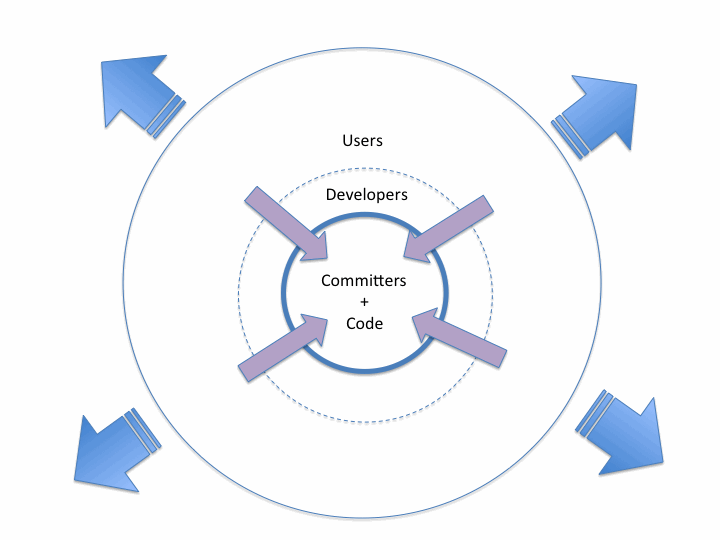
As the software at the core of the project is the dynamic thing (the "meme" to replicate), we need developers capable of contributing to the project. Developers that might contribute are people that probably started as users of the software project. They found the software, used it, perhaps fixed a bug, perhaps added a feature, or repurposed the software to a new problem. At this point they are in a position to contribute, but there’s work to be done to encourage and allow that contribution.
So, there are three onramps that a FOSS project’s committer(s) need to build and relentlessly improve:
- Attract lots of users: The software needs to be easy to install/configure/use (and this applies to developer tools, libraries, and frameworks as much as to user space apps and tools).
- Out of this user base, attract developers: The software needs to be easy to download, and build and test to a known state. This allows potential developers to experiment/fix/extend the software project FOR THEMSELVES and their own selfish needs.
- Out of this pool of developers, attract contributors because there's actually a well thought out pipeline and communications about what, where, and how to contribute. Contributions DO come from users, for example bug reports.But a project still needs to communicate with users to enable them to contribute good bug reports.
We have seen these pipelines anecdotally for years.
- In the early days of PC-based software (in the early '90s) there was the 5-Minute Rule (or 10-Minute Rule depending on who you consulted) that said if the software didn't install and do something useful [very] quickly it became shelfware. Today, how many people download an open source project and never get it working and walk away? How much time are you willing to invest installing, configuring, building, testing, working through the forums, before you declare defeat and move on. How many potential contributors do you leave feeling frustrated and stupid?
- There was an idea expressed by core committers in some open source communities 10-15 years ago that said it's orders of magnitude between communities and contributions, i.e. for every 1000 users, you might see 100 bug reports, out of which 10 will send code that purports to fix said bug, out of which 1 read your coding guidelines and really did fix the bug. I heard this from a couple of communities (BIG = sendmail, small = graphics drivers) and have "tested" the statement on many core committers since who all stop, think, and agree. (Caveat lector: This is purely anecdotal. I’m thinking about ways to hunt through the data streams for proof along the lines of Donnie Berkholz’s excellent recent investigation.) We see it in statements in their talks from the likes of Jono Bacon ("we want to turn drive by contributors into regular contributors"), Kohsuke Kawaguchi ("potential contributors start as visitors to your website"), and Donnie Berkholz ("your future potential contributors start by lurking on your project's communications channels").
- Tim O’Reilly wrote "The Architecture of Participation" in 2004 describing the nature of systems that are designed for user contribution and extending Mitch Kapor’s meme on "architecture is politics."
There are patterns and practices successful FOSS projects use to grow and evolve the community (users + developers + contributors), and thereby ultimately the software itself. Each group in the community needs an onramp. These activities can be arranged along two axes:
- Software construction: The patterns and practices that make the software itself easy to install, configure, run, build, test to a known state.
- Community development: The patterns and practices that encourage the participation of the people that will grow the user base.
So if we look at the onramps in light of the axes, we get the following diagrams.
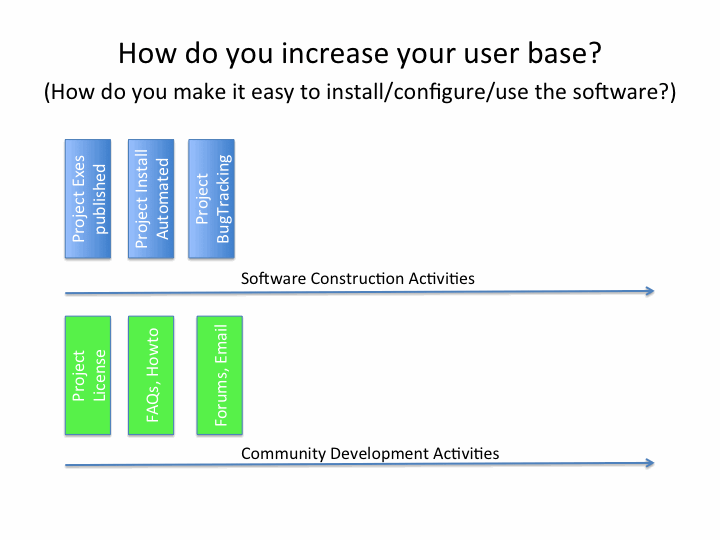
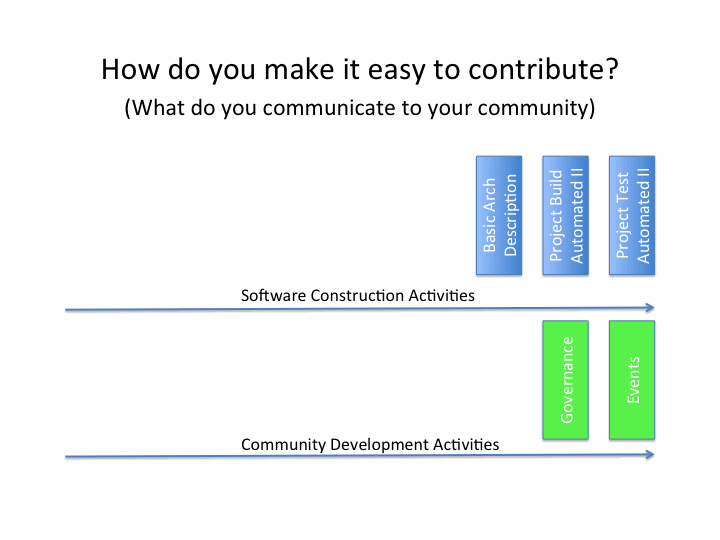
Once a project begins to grow, there will be commercial interest. Companies will want to use the software in interesting ways in their own products and services, or provide services around the project to other users. At this point, there are an additional set of activities a project needs to undertake for community growth and contribution flow. (These activities make up their own axis so really there are three axes):
- IP management: The patterns and practices that encourage commercial participation that allows an ecosystem to take hold.

So, driving open source project success is an exercise in building onramps for communities of users, developers, and contributors, and eventually commercial contributors to enable an project ecosystem.
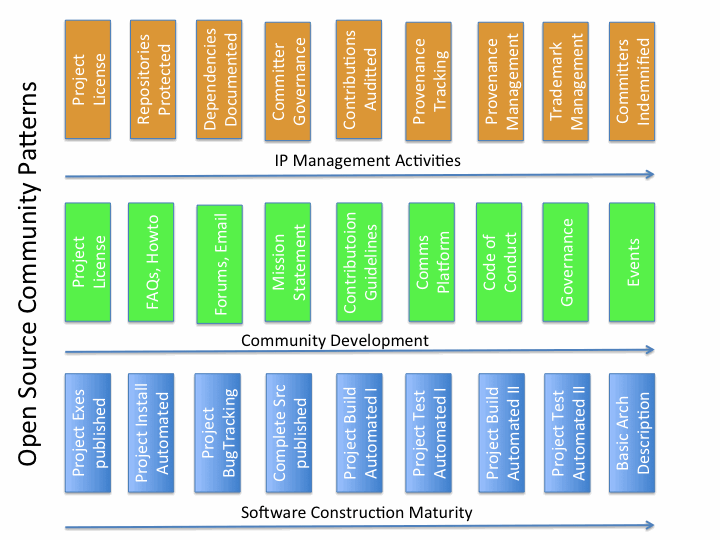
I’ve written and presented before now on the role of foundations enabling growth. Many of the IP management issues are handled by free and open source software foundations, as they create neutral non-profit spaces for IP sharing and collaboration. Looking at the history of the Apache Software Foundation, with its incubation program to drive certain software construction and community development activities, and the role of the foundation IP structure itself, one can see the practices and patterns for open source software project success. The "Apache Way" is a reflection of the patterns and practices.
So too, with the Eclipse Foundation, its rigorous IP management and development practices and community support, and the Linux Foundation support for the Linux ecosystem. One can see this as far back as the Free Software Foundation and gcc and the enablement of a C-compiler ecosystem for the likes of Cygnus Software, and the Outercurve Foundation continues the tradition of supporting the three axes of activities for FOSS project success.
So, to summarize:
- Successful FOSS projects grow their communities outward to drive contribution to the core project.
- To build that community, a project needs to develop three onramps for software users, developers, and contributors, and ultimately commercial contributors.
- The patterns and practices involved in the onramps can be arranged along three axes of software construction activities, community development activities, and IP management activities.
- Build the onramps, and one builds the potential for the ecosystem.
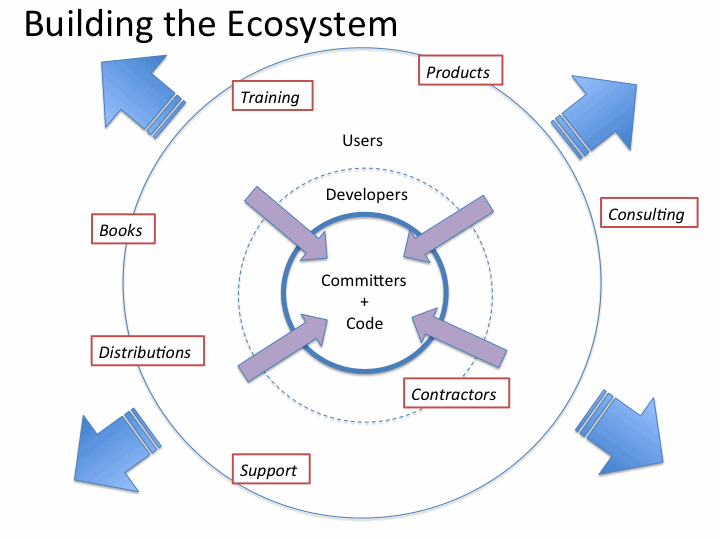
I've written about many of these ideas over the past year, but without the framework. I presented the framework of patterns and practices for the first time at the Outercurve Foundation Open Source Software Conference in May this year [video below]. I'm looking forward to continuing the discussion through this next week at the Community Leadership Summit and OSCON 2013.
Originally posted on Stephen's blog. Reposted under Creative Commons.

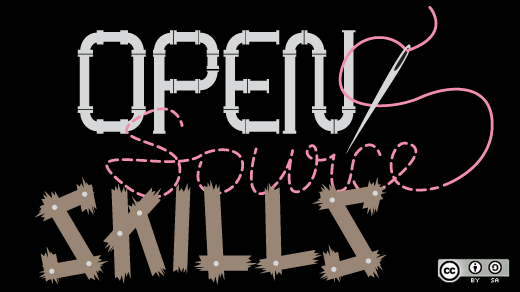



1 Comment